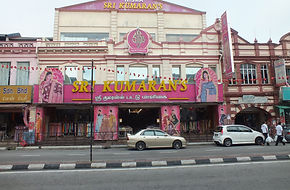

in Future Real Estate Development
Way of Architectural Vision
2010-2012
2013 Aug - Dec
2014 Aug - Dec
Culture & History II
Project 1 : ARCHITECTURE HERITAGE BUILDING ANALYSIS



Wisma Sri Kumaran’s was built in year 1916 owned by three different owners for each of the three shop lots (lot 89, lot 90 & lot 91) in different year located along Jalan Tengku Kelana. It is three shop lots with two storeys combined shop house and has an estimated built up area of 288 meters square. In the past, before Malaysia independence Wisma Sri Kumaran’s was money lending retails owned by India money lenders in year 1930 – year 1960. In year 1960 due to Malaysia independence, many outsiders was force to return to their country it is then this three shop lots are sold to local Chinese business man. Lot 89 and lot 90 was both sold to a Rice Whole Sale shop owner, where lot 91 are sold to a Bicycle shop owner. Later in year 1998 – year 2000 this three shop lots are then rented to an Indian textile shop, Sri Kumaran’s textile shop and then bought over by Sri Kumaran’s Pattu Maligai Sdn.Bhd in year 2000. After remaining as it original form for three years, in year 2003 the shop is renovated to have bigger area to fit the user. The building was then renovated from a two storeys shop house into a four storeys shop house giving it a new built up area approximately around 576 meters square.

Introduction
Klang is one of the oldest town in Selangor. The importance of Klang elevated in 19th century due to the rapid expansion of tin mining activities in Klang Valley. After 1874, the British opted for Klang over Jugra as the centre of their administration, and this remained until 1880 when they moved it to the mining centre of Kuala Lumpur. Despite the transition, Klang did not lose its greatness, and remained renown with the construction of Port Klang (formerly known as Port Swettenham) in 1901, which made the royal town the chief outlet for
Selangor’s tin. In addition, its position was enhanced in 1886 by the Klang Valley railway. In the 1980’s the town’s growth was further stimulated by the State becoming a leading producer of coffee and rubber. Today, many majordevelopments are taking place in Klang thus changing further its current conditions in term of urban layout and architecture. Without proper documentation of what was there, future generations might not know the city; its origin and development. Therefore, this project attempts to document Klang through report and analysis.
Learning Outcomes
1. Interpret architectural language in relation to the development of Western architecture between Industrial Revolution and post World
War 2.
2. Differentiate the way in which many varied factors contribute to the development of form.
3. Ability to extract important information and present them in your own style
© 2013 by Lexusck's Arch-Studio. Proudly created with Wix.com



